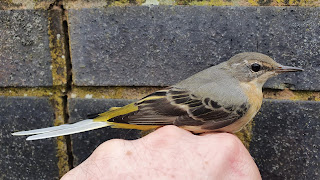As you will see a bit later--it has; but before that just a quick mention of a lovely bird that Kev caught on his final August visit to the racecourse. Within this site there is a pool area, and one of the wagtail family in particular is attracted to water--the Grey Wagtail. These are stunning looking birds--especially males in Spring, and they have the longest 'waggiest' tail of the wagtail family.
This is a juvenile so not quite as colourful--but you can see that there is a lot of bright yellow towards the back end of the bird. This shows up really well in the field and leads to a lot of mis-identification. People sometimes report these as Yellow Wagtails--but the overall grey colour above signals that this is a Grey Wagtail.
Wednesday 1st September saw the team assemble at Belvide for a regular session in reasonably still, overcast weather. Catching was steady all session, and resulted in a super catch of 82 new birds--mainly migrants of a wide range of species. But this time I thought I'd feature a couple of resident breeding birds for you.
First, any ringing session with one of these birds is a success.....
Kingfishers never fail to please!! I thought I would catch this bird in a pose which really shows of the brilliant shimmering blue colour on the back and rump--often all you see as it darts away along a canal or river. The lower mandible on this bird showed just a hint of red which might make it a female--but there was so little red we thought it best to leave is as unsexed. What a stunner!!
In it's own way this next bird is stunning -if in a rather more subtle way.....
It's a Treecreeper, showing the cryptic plumage to help it hide against the bark of trees--and showing the long, decurved bill which it uses to poke into crevices looking for morsels of food--spiders, insects, invertebrate eggs and grubs etc. as it spirals its way up tree trunks.
This morning Ben was at his Witches Oak site with Simon and again they racked up a smashing total of 58 new birds--mainly warblers of which Blackcaps were the majority. However, Ben reports a good number of........
The rusty coloured wing feathers identify this as a Common Whitethroat. This is a juvenile in absolutely pristine, post fledging plumage--shortly to set off on it's way to western Africa.




No comments:
Post a Comment